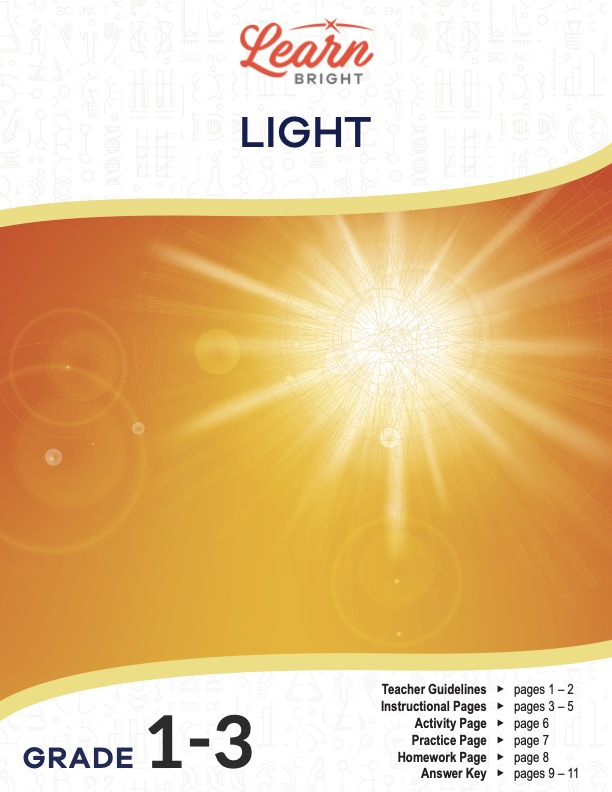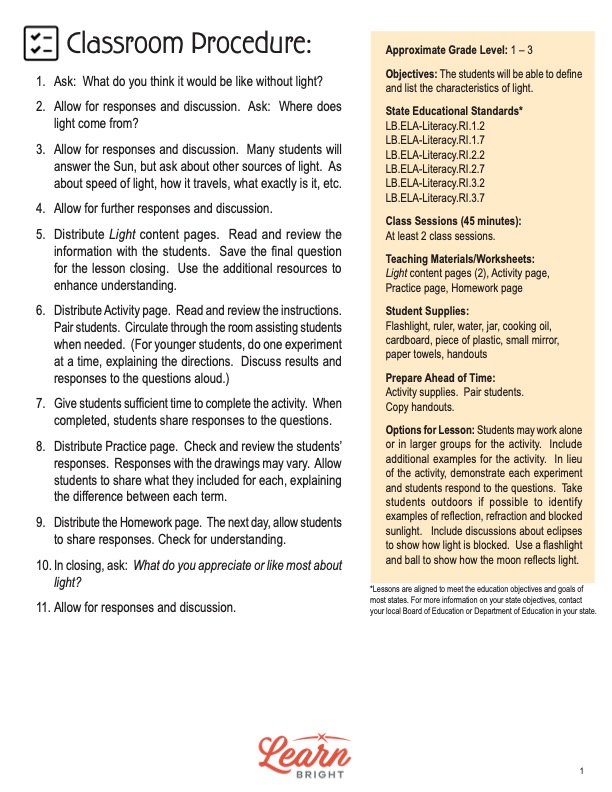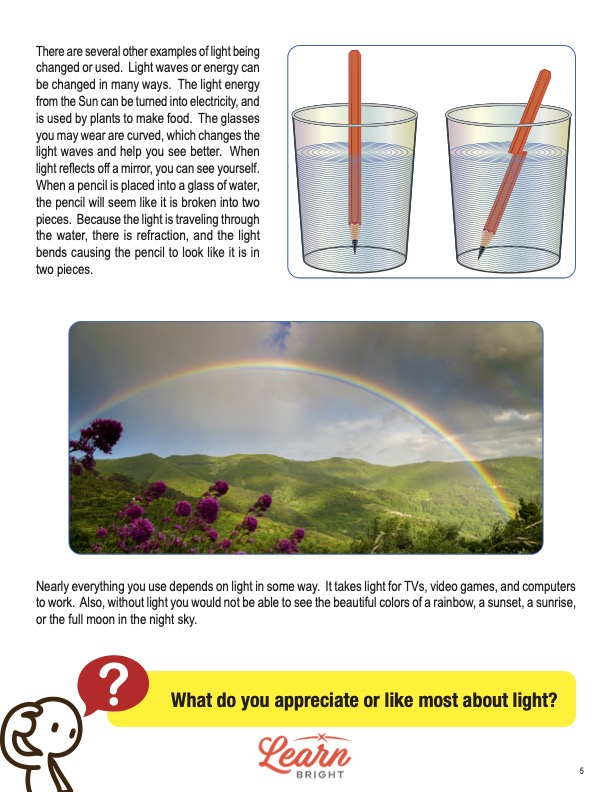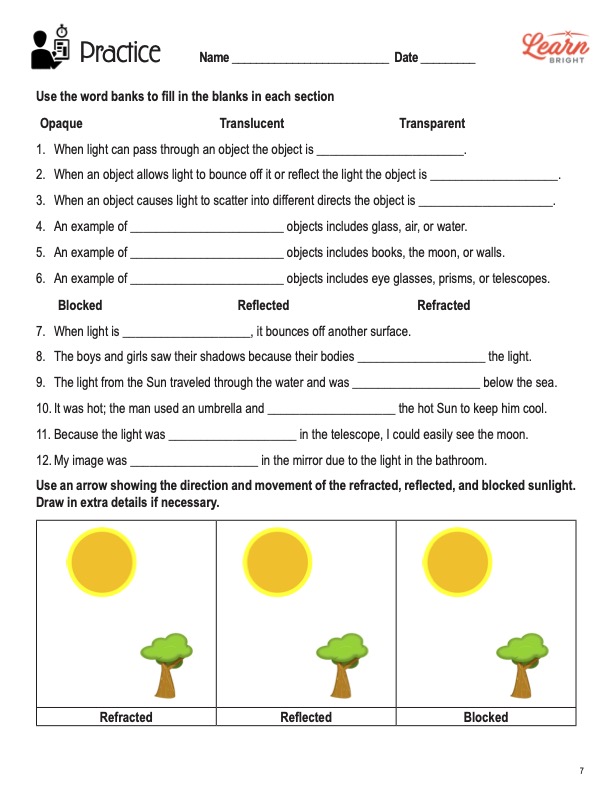Description
What our Light lesson plan includes
Lesson Objectives and Overview: Light explores the unique traits of light, its energy, and its effects and uses. Students will learn how it can change or how people control it. They will also discover that the qualities of certain objects either allow light through or block it. This lesson is for students in 1st grade, 2nd grade, and 3rd grade.
Classroom Procedure
Every lesson plan provides you with a classroom procedure page that outlines a step-by-step guide to follow. You do not have to follow the guide exactly. The guide helps you organize the lesson and details when to hand out worksheets. It also lists information in the yellow box that you might find useful. You will find the lesson objectives, state standards, and number of class sessions the lesson should take to complete in this area. In addition, it describes the supplies you will need as well as what and how you need to prepare beforehand. The supplies you will need in addition to the worksheets are flashlights, rulers, water, jars, cooking oil, cardboard, pieces of plastic, small mirrors, and paper towels.
Options for Lesson
There are several ideas in the “Options for Lesson” section that you could take advantage of if you have extra time or want to extend the lesson. One idea is to add other objects to the experiments for the activity. You could also demonstrate each experiment and have students respond to the questions. Another idea is to take the students outside to search for examples of reflection, refraction, and blocked light. You could also discuss the concept of an eclipse and show how the earth or moon can block the sunlight. A final idea is to use a flashlight and a ball to show how the moon reflects light at nighttime.
Teacher Notes
The paragraph on this page provides a little more guidance or information regarding the lesson. It suggests using videos or other resources to reinforce the concepts of the lesson. You can use the blank lines to write down any other thoughts or ideas you have before presenting the lesson to your class.
LIGHT LESSON PLAN CONTENT PAGES
What Is Light?
The Light lesson plan contains three pages of content. The lesson begins by describing how light is almost everywhere. When it isn’t there, it can be scary. Students will learn that without light, life could not exist. Light is a form of energy that is visible when it reflects off the surfaces of objects. Its waves travel at a speed of 186,000 miles per second! That means that it takes roughly 8 minutes for sunlight to reach the earth, which is 93 million miles away from the sun. In fact, scientists believe there is nothing that travels faster in the whole universe.
Light can travel through certain objects, but not all of them. For the most part, it can’t travel through solids, but it can travel through liquids and gases. If an object is transparent, for instance, light can travel through it. For example, even though glass is solid, it is transparent or clear, like water and air. Therefore, light can pass through it. Opaque objects, on the other hand, do not allow light to pass through. Instead, it bounces off the surface of the object, or reflects off the object’s surface. And translucent objects cause light to scatter in different directions because the object is somewhere in between transparent and opaque.
Controlling and Changing
While light travels in a straight line, there are three main ways people can control or change its direction. The first is reflection. Reflection occurs when light waves bounce off a surface, which makes that surface visible. Otherwise, it would remain impossible to see it. For instance, the moon does not emit any light. The sunlight travels millions of miles in a matter of minutes and reflects off the moon at nighttime, making the moon visible to one side of the world.
The next way is refraction. Refraction occurs when light waves bend or turn, changing their direction. A common example is when light travels through water or other transparent objects, like glasses and telescopes. The direction and speed of the light change. The lesson provides the example of a prism. When light hits a prism on one side, it refracts into the seven colors of the rainbow, each at a different angle, on another side.
Finally, there is blocked light. Non-transparent objects block light completely. Examples include objects like sun visors, umbrellas, or even the moon during an eclipse. Similarly, people are non-transparent, so when light runs into a person, the result is a shadow of that person.
There are other ways light can change. People, plants, and other things also use light in different ways. Plants use to it make food. People can convert its energy into electricity. People also use mirrors to see themselves, which would be useless without light. Eye glasses have curved lenses specifically to control how light bends to help people see better. Nearly everything we use depends on light in some way.
Key Terms
Here is a list of the vocabulary words that students will learn in this lesson plan:
- Light: a form of energy that we can see when it reflects off the surface of an object
- Transparent: a term to describe an object that light can pass through, such as air, water, or glass
- Opaque: a term to describe an object that light bounces off and cannot pass through
- Translucent: a term to describe objects that scatter light in different directions
- Reflection: when light waves bounce off a surface
- Refraction: when light bends or turns and changes its path
LIGHT LESSON PLAN WORKSHEETS
The Light lesson plan includes three worksheets: an activity worksheet, a practice worksheet, and a homework assignment. Each one will help students solidify their grasp of the material they learned about throughout the lesson. Refer to the guide on the classroom procedure page, which outlines when to hand out each worksheet.
FOUR EXPERIMENTS ACTIVITY WORKSHEET
The activity requires students to perform four experiments. There are specific supplies and directions for each one. The first three tests ask students to write down what they noticed and whether or not they observed reflection, refraction, or blocked light. The last test asks them to write what they noticed and then decide which object is transparent, which is translucent, and which is opaque. Students will likely need extra paper to write down their observations throughout the experiments.
FILL IN THE BLANK PRACTICE WORKSHEET
The practice worksheet is split into two sections. The first section lists two groups of six sentences. Each group of statements is accompanied by a word bank. Students will fill in the blanks in the sentences using the terms in the corresponding word bank. The second section requires students to draw arrows to show the direction and movement of refracted, reflected, and blocked sunlight. Students can draw in extra details on the pictures if they want to.
LIGHT HOMEWORK ASSIGNMENT
There are two sections for the homework assignment. The first section provides a table with 12 boxes. With the help of a family member, students will search their home and neighborhood to find two examples each for reflection, refraction, and blocked light. There are two boxes for each example. In the top boxes, students will draw pictures to represent the example they chose. In the bottom box, they will describe why the example represents the type of change they used. The second part of the worksheet lists three definitions. Students will write the word that the definition represents and write down a few examples of that concept.
Worksheet Answer Keys
The final pages of the lesson plan are answer keys for the worksheets. The answers are all in red to make them easy to recognize. For the activity, answers will vary a little but should roughly reflect the responses on the answer key. Similarly, students’ representations for the second section of the practice worksheet may vary from the answer key. The homework answer key provides only the correct terms for the definitions in the second part of the assignment. Students’ responses to the rest of the assignment will vary. If you choose to administer the lesson pages to your students via PDF, you will need to save a new file that omits these pages. Otherwise, you can simply print out the applicable pages and keep these as reference for yourself when grading assignments.










